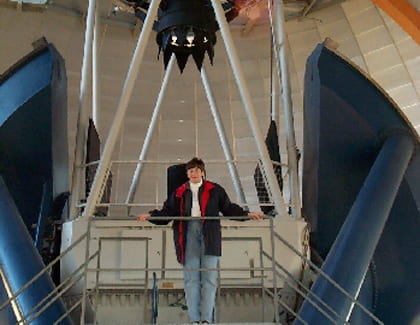Sky’s the limit
Observatory director Tammy Smecker-Hane handles all kinds of questions on the cosmos
When the phone rings in Tammy Smecker-Hane’s office, it may be a student asking about the distribution of iron abundance in galactic bulge stars or a concerned citizen wondering if that strange green glow in the night sky was caused by a UFO.
No question in the universe, it seems, is off-limits when you’re director of the UCI Observatory and assistant professor of physics. Whether she’s speaking to local third graders about the solar system or UCI undergraduates about galaxy formation, Smecker-Hane seeks to educate her audience about the heavens above. And that audience is expanding.
On the observatory’s visitor nights, the number of astronomy buffs, students and stargazers who gather for a close-up view of the sky has increased from about 100 in 1995 to about a thousand today. People line up to peer through the observatory’s 24-inch and 8.5-inch telescopes, often seeing Saturn’s ethereal rings or Orion Nebula’s star-forming cloud for the first time. To handle the crowds, the Department of Physics & Astronomy has added a team of volunteers and two shuttle buses funded by a National Science Foundation grant. (The next visitor nights are April 13 and May 18.)
“Nearly everyone loves astronomy, and it’s great publicity for the university,” says Smecker-Hane, who started the visitor nights, which are now held five times a year.
She also started the Astronomy Club at UCI for undergraduates to educate people about astronomy research, especially that being done by high-powered telescopes like the W.M. Keck Observatory and Hubble Space Telescope.
Smecker-Hane especially enjoys getting kids excited about astronomy. The department offers outreach programs for students in the Compton, Santa Ana and Newport-Mesa school districts, inviting them to field trips at the observatory and giving presentations at their schools, often setting up scale models of the solar system and telescopes to view sunspots and solar flares. Her outreach program reaches about 2,500 youngsters annually.
As a child, Smecker-Hane learned about the solar system when her parents took her to their local planetarium in Pittsburgh; they wanted to expose their children to different educational experiences. Smecker-Hane was first in her family to go to college.
She got serious about astronomy as a graduate student at John Hopkins University, where she got her doctorate in physics in 1993. Today, she studies the formation and evolution of galaxies. She loves visiting observatories in far-off places, especially the world’s two largest 10-meter telescopes at the W.M. Keck Observatory on the summit of Mauna Kea, Hawaii.
“Astronomy is still a young science,” she says. “It’s a field where one person or a small group of people can still make a huge discovery.”


